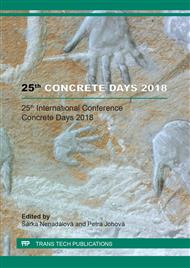p.79
p.85
p.91
p.96
p.102
p.108
p.114
p.123
p.128
The Effect of Homogenization Procedure on Mechanical Properties of High-Performance Concrete with Partial Replacement of Cement by Supplementary Cementitious Materials
Abstract:
High-performance concrete is a very specific type of concrete. Its production is sensitive to both the quality of compounds used and the order of addition of particular compounds during the homogenization process. The mechanical properties were observed for four dosing procedures of each of the three tested concrete mixtures. The four dosing procedures were identical for the three mixes. The three mixes varied only in the type of supplementary cementitious material used and in water content. The water content difference was caused by variable k-value of particular additives. The water-to-binder ratio was kept constant for all the concretes. The additives used were metakaolin, fly ash and microsilica. The comparison of particular dosing procedures was carried out on the values of basic mechanical properties of concrete. The paper compares compressive strength and depth of penetration of water under pressure. Besides the comparsion of macro-mechanical properties, the effect of microsilica and fly ash additives on micro-mechanical properties was observed with the use of scanning electron microscopy (SEM) and nanoindentation data analysis. Nanoindentation was used to determine the thickness and strength of interfacial transition zone (ITZ) for different sequence of addition of cement, additive and aggregate. The thickness obtained by nanoindentation was further investigated by SEM EDS line scanning.
Info:
Periodical:
Pages:
102-107
Citation:
Online since:
June 2019
Authors:
Price:
Сopyright:
© 2019 Trans Tech Publications Ltd. All Rights Reserved
Share:
Citation:


